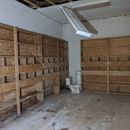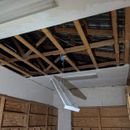How to cost effectively (initially and operationally over time) have climate controlled storage
I recently purchased a property in Calhoun, (SE) Tennessee – climate zone 4A – that has a 35′ X 80′ shop on it. The shop is partitioned off into several rooms that are each only accessible from the outside. I want to use one of these rooms (12′ x 24′ with 10′ ceilings) as a climate controlled storage area. My primary interest in in controlling moisture to keep tools and other items from rusting but, if it wouldn’t cost much more operationally, it would be nice to have modest temperature control.
From the attached pictures, you can see that the walls are painted OSB with a drywall ceiling that needs repair. The exterior is insulated with R-13 fiberglass but the interior partitions are not insulated. There is some built-in shelving that I plan to remove.
I was originally planning on removing the OSB on the interior walls so that I could insulate the stud cavities and then put finished drywall where OSB used to be. The OSB is well nailed and would be a job to remove. I then got the idea that it might make more sense to just use just put some 1/2 or 3/4″ XPS on top of the OSB and tape the seams to create a fairly airtight space, albeit with a lower R-value than fiberglass in the walls. Another thought was to cut out a 2′ section of OSB at the top and bottom of the interior walls and “feed” fiberglass from top to bottom. The practicality of that will probably depend on how many fasteners are penetrating the wall cavity. I also planned to roll out fiberglass batts in the ceiling.
The other question is how to provide the climate control. I can provide humidity control only with a dehumidifier (with additional heat gain from the unit) or I can use a mini-split or window unit through the wall and control both latent and sensible loads.
I’m interested to hear if anyone has opinions on the following:
Does temperature control really matter to protect stored items, tools, etc? I suppose it could get to 90+ degrees Fahrenheit in the summer with no temperature control, perhaps more with the operation of a dehumidifier.
If temperature control doesn’t matter, is there any point in insulating? In that case, what would be a good way to retrofit this room to keep the moisture out and reduce the run time of a dehumidifier?
If insulation does matter, what would you recommend? Any ideas beyond what I was thinking?
Would an Energy Star dehumidifier use substantially less energy than, say, a 20+ SEER mini-split set to, say, 85 degrees, that I would self-install – I have all the tools and have installed them before. Of course the mini-split option is not going to help remove moisture during the cooler times of year.
Thanks for any thoughts and opinions you have on this topic.
GBA Detail Library
A collection of one thousand construction details organized by climate and house part












Replies
Consider blown in cellulose in the walls without insulation. And then blower door assisted air sealing. Optional: vapor barrier paint on the cellulose filled OSB.
Do not count on a mini-split doing an adequate job of dehumidifying, even during somewhat hot weather.